PALLET
THE BEST SOLUTIONS FOR PALLET RACKING MELBOURNE
Get a competitively-priced pallet racking system with Bo Racking. Our systems are designed to improve overall efficiency at your Melbourne-based warehouse, storage facility or retail outlet improve. We think time is a precious currency, which is why we supply efficient installation and pallet racking designs that will ensure the optimal running of your warehouse storage.
OUR PALLET RACKING SERVICES
SELECTIVE PALLET RACKING

Because of its versatility and the range of custom options available, selective pallet racking is well suited to a variety of storage environments, ranging from small facilities to large warehouses.
Pros / Every pallet is easy accessible, compatible with nearly every forklift
Cons / Other storage solutions are able to create more pallet spaces than this solution
Forklift Requirements / No Special Requirements
Best fit and Use / Best suited for warehouses with a high intake and outgoing of pallets
Our pallet racking is certified, not just complies, to Australia’s most recent steel and safety standard AS4084-2012. This can be very important to your business for safety and insurance purposes.
DOUBLE DEEP PALLET RACKING
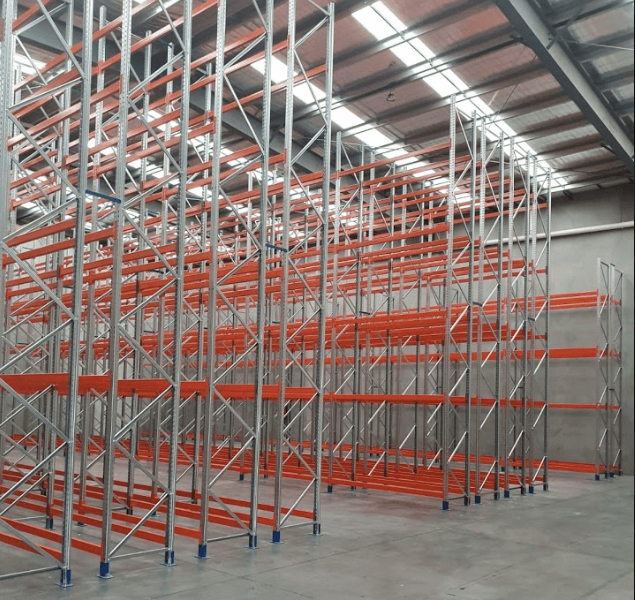
Double Deep Pallet Racking is designed to maximise storage space in your warehouse or storage facility by removing the need for aisles, it is ideal for slow moving stock or long term storage.
Pros / Maximizes the storage space by removing the need of aisles
Cons / Access of pallets stored in the 2nd row can take some extra time
Forklift Requirements / A double deep reach forklift is mandatory
Best fit and Use / Best suited for warehouses with slow moving stock or long term storage
CANTILEVER RACKING

Cantilever racking is an essential solution for loads that must have no ‘face’ obstruction, so that hefty and odd sized products can be easily stored and accessed. This type of cantilever racking allows you to use your warehouse space more efficiently, ¬ you’ll never need to clutter floor areas with annoying columns obstructing your storage space again.
You can easily fit these systems within your facility by adjusting the height, ensuring that the most amount of vertical storage space is exploited. The open rows allow secure load support and also easy access, safety, flexibility and selective ability are all maintained to a gold standard.
Pros / Allows to store hefty and odd sized products in an easy manner and product is easy accessible at all time
Arms are easy to adjust in height to allow a customization suited to your product
Cons / Not suited for standard size pallets. Only for oversized pallets and other long materials
Forklift Requirements / No Special Requirements
Best fit and Use / Best suited for warehouses which stock store long, bulky, and oversized loads like timber, pipes, trusses and plywood
DRIVE IN RACKING
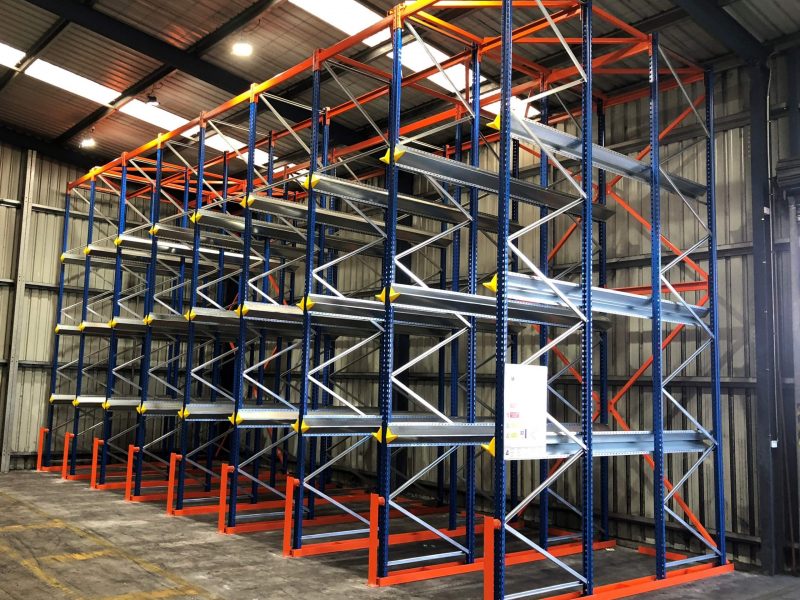
Drive in Pallet Racking is ideal for stocking many products. It can reduce overall Sq. footage requirements by 35% or more compared to standard selective racking. It is widely used in cold storage and food industries.If you are storing large volumes of goods, we offer a Drive In Racking system that can free up existing floor space. Our Drive In Racking system creates efficiency by decreasing aisle loading & unloading times, yet allowing greater access in comparison to block stacking.
Pros / Maximizes the storage space by removing the need of aisles, Compatible with most forklifts
Cons / Access of pallets stored in the back is restricted
Forklift Requirements / No Special Requirements
Best fit and Use / Best suited for warehouses with slow moving stock or long term storage
NARROW-AISLE RACKING
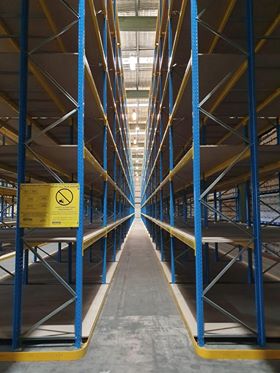
Narrow Aisle Racking provides 100% pallet accessibility whilst increasing storage space within your warehouse. Narrow Aisle Racking is ideal for all types of pallet storage, and can be built to accommodate different sized pallets on each level.
Pros / Increases the storage space while the accessibility of each pallet is not affected
Cons / Narrower aisles can slow down the process and needs skilled forklift operators
Forklift Requirements / Narrow Aisle reach forklift or order picker is mandatory
Best fit and Use / Best suited for warehouses with a high intake and outgoing of pallets
PALLET FLOW/LIVE STORAGE
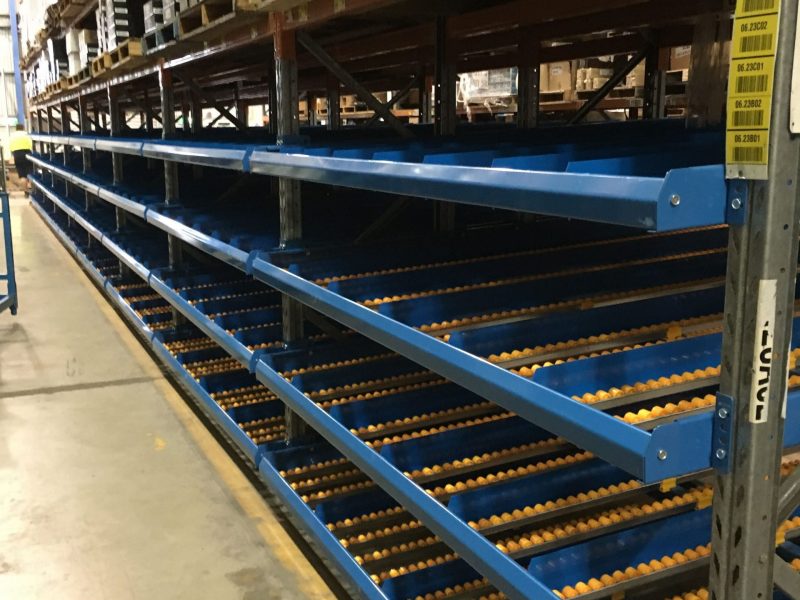
Pallet flow is the most common FIFO (1st in-1st out) system. Pallet flow uses roll tracks to send pallets from on load end to offload end with a forklift only dropping off or picking up single pallets, with no need to “enter” the rack structure saving time and also constant repairs of internal framing when accidentally damaged.
Pros / Maximize the storage space by removing the need for aisles, Compatible with nearly every forklift
Cons / Accessibility of pallets is restricted
Forklift Requirements / No Special Requirements
Best fit and Use / Best suited for warehouses with the FIFO System (First in – First out)
WAREHOUSE RACKING ACCESORIES

Bo Racking uses a wide range of warehouse racking accessories. If you don’t see what you’re looking for here contact us and we will find it. We are committed to keeping your pallet racking safe and up to date.
• Rollover Gate for Mezzanine
• Heavy Duty Castor (With Brake)
• End Row Barriers
• Post Protectors
• Timber Support Bars
• Safety Clips
• Collapsible Stillage
• Wire Mesh Deck
WHY CHOOSE US

LEAVE YOUR WAREHOUSE RACKING NEEDS TO US
Not sure which type of Pallet Racking approach works best for your organisation? Our entire team here at Bo Racking is ready to help. From Selective Pallet Racking, through to heavy duty industrial options. Bo Racking brings Australia’s leading suppliers and brands to the businesses of Melbourne with ease so you have access to the best-suited storage products for your needs.
WAREHOUSE RACKING SOLUTIONS THAT COMPLY
The Australian Standards AS4084-2012 is our rule book which is why our installers carry full insurance cover no matter where in the country they may be working. We ensure a safe Warehouse Racking Installation process and have access to all necessary equipment, including scissor lifts and more to complete your project correctly. With Bo Racking on the job, a positive and beneficial outcome for tailor-made warehouse projects is guaranteed.

PALLET RACKING INSTALLATION FAQ
Does it matter if rack frame braces are damaged?
It definitely matters. The horizontal and diagonal members of the rack frame are designed by the rack manufacturer to stabilize the rack frame in the cross-aisle direction and to support each of the individual columns. If any of these rack frames are damaged, it could put the stability of the frames at risk of a potential rack failure.
If you find yourself in a situation that involves a damaged rack frame, you should promptly isolate the affected area, have a storage rack design professional assess the damage, and follow their advice.
What is a tunnel bay and what are some of the special considerations?
A tunnel bay is a storage rack bay that has the lower beam levels removed to allow people or lift equipment to pass through the rack in the direction that is perpendicular to the storage rack aisles for the purpose of egress, and also to provide more efficient travel distance to stored loads. The person preparing the rack layout should work closely with the rack user to determine the most optimum locations for tunnel bays. Longer systems may require more than one tunnel bay location.
Special consideration should be taken for tunnel bays that are placed at the ends of the rows, because special design of the frame may be required to allow for the longer unbraced column length. Tunnel bay frames are often reinforced or equipped with protective devices, because they are more vulnerable to damage from cross-traffic or turning vehicles. The clear height of tunnel bays should be adequate to allow for the vehicle to pass through safely. Tunnel bays are often wider than standard bays. The first shelf level of tunnel bays is often protected by wire decks or other guarding.
What is a Pick-Module?
A pick-module is a rack structure comprised primarily of vertical frames and horizontal beams, typically having one or more platform levels of selective, case-flow, or pallet-flow bays feeding into a central pick aisle(s) supported by the rack structure. Pick modules are used by authorized or trained personnel only, and are not open to the general public.
If I do need a permit, what materials are normally required from the rack supplier and from the owner? Is there a cost for this?
The materials required for a building permit normally include the details of the proposed rack system and its use, the various loads for which it has been designed, the “calculations” from an engineering analysis accomplished and “sealed” by a registered design professional, demonstrating the structural integrity of the proposed system and its conformance with all applicable building code provisions, details of the fabrication and installation processes, information about the building in which the rack system will be housed and used. The building information may include relevant information about the characteristics of the floor slab, the below-slab soils, and about the building structure if connections to the building are proposed.
Typically the owner works with the rack supplier to assemble and process this information through the permitting process. There may be costs associated with the development and processing of this information through the local permitting process and for a building permit itself. The magnitude of these costs and how they are shared are matters of negotiation between the owner and the rack supplier and may relate to the size, complexity, and site-specific requirements of particular projects.
Why should pallet racks be anchored?
The ANSI/RMI specification requires that all rack columns should be anchored. This means that both the aisle column and the interior or rear columns must be anchored on all frames according to the instructions from the manufacturer and applies to all rack frames all the time. If there is a specific application where the racks can’t be anchored, the user should get permission from the manufacturer’s engineer to waive the requirement. Anchors are required to resist many forces at the base of the columns and to maintain the position of the rack column.
What size anchor should I use
The rack manufacturer should be able to provide the information on the proper quantity and size of anchors for the installation of its rack frame. This information should accompany installation instructions or on installation drawings. A ½” diameter anchor with the proper embedment depth is commonly the anchor bolt used for medium sized pallet racks in non-seismic areas. If there is any uncertainty as to the anchoring requirement, the rack user or installer should contact the designer or the manufacturer regarding the anchoring requirement for that specific application.
Can storage rack be installed on floors (surfaces) other than concrete?
Some lightweight storage rack applications may be installed on surfaces other than concrete such as wood decking, bar grating or other materials, but a qualified design engineer must review the means for anchoring or attaching. The rack user should provide a qualified design engineer with the necessary loads and configuration, and any other information that is required, to evaluate the ability of the floor system to support the rack column loads and the method for attaching or anchoring the rack.
How far out-of plumb can my racks be before I should fix them?
The ANSI/RMI Specification shows the maximum out-of-plumb ratio for a loaded rack column as 1/2″ per 10 feet of height. Columns whose out-of-plumb ratio exceeds this limit must be unloaded and re-plumbed. Any damaged parts must be repaired or replaced. This ratio could be used for straightness also. In other words, the out-of-straightness limit between any two points on a column should not exceed 0.05″ per foot of length (1/2″ per 10 feet).
An out-of-plumb or out-of-straight condition will reduce the capacity of a rack column. The reduction can be significant. A rack that is out-of-plumb from top to bottom or a rack column that is not straight is likely to become further out-of-plumb or out-of-straight when it is loaded.
The out-of-straight limit is given to prevent excessive “bows” or “dogleg” conditions that may exist in a rack column. A column could be plumb from top to bottom but have an unacceptable bow at mid-height (see figure (a)), or a 20 ft. high column could be out 1″ from top to bottom, which could be acceptable using a simple top-to-bottom out-of-plumb measurement, but the entire out-of-plumb could be between the floor and the 5 ft. level (see figure (b)). This dogleg condition would be very harmful. This condition could be caused by fork truck impact. The column could have a sine wave shape and be out of straight as shown in figure(c). A column could also become bent and exceed this limit (see figure (d)). As re-written the specification now prevents these situations from being acceptable if they exceed the 0.05″ per foot out of straight limit.
How much pallet beam deflection is acceptable?
At normal design working loads, beams are typically designed to accommodate vertical deflections that do not exceed 1/180 (or 0.55 percent) of the horizontal beam length as measured with respect to the ends of the beams. Some users may specify a lesser-deflection requirement for visual appearance or cosmetic purposes. Still other users with systems intended to use more precise automated storage and retrieval equipment may specify a lesser-deflection requirement. (See ANSI/RMI Specification section 5.3, Commentary section 5.3).
What should I do if I want to reconfigure my load beam elevations?
Pallet racks are originally designed for configurations requested by the owner. These configurations are shown on the Load Application and Rack Configuration Drawings supplied to the owner. Changing the racks to a configuration that was not considered in the design may create an unsafe condition. A qualified engineer should review any change to the bay configuration that is different from the original design configurations.
Is it permissible to add frame extensions to the tops of upright frames to increase the height of existing pallet storage rack frames?
If the reason for extending the height of the pallet rack upright frames involves a change in the existing beam elevations or the addition of one or more bean levels, the design configuration of the rack is being changed. Prior to making any such changes to the configuration or loads, the original and proposed rack design should be reviewed by the original manufacturer or by a qualified design professional.
All rack components and connections must be checked with the new loads and the revised configuration to ensure that all the requirements of the ANSI/RMI Specification are satisfied for the new configuration and loads. The splice connection used must adequately transfer all loads from the frame extension to the existing frame. The frame extension must have proper bracing and be compatible with the beams or other components that will connect to it for the new configuration. In some cases individual column extensions may be acceptable. If the rack configuration or load change is made and the extensions are added, it may be necessary to revise or replace the information on the load plaques and the rack application drawings.
If the reason for extending the frames is for non-structural purposes, the design review may not be required. If the racks are being extended to add cross-aisle ties for any reason, the design should be reviewed because the cross-aisle design model of the racks will be altered. If the racks are being extended for the purpose of tying the racks to the building, the design should be reviewed and the building design engineer must approve the connections. Any rack frames that are damaged must be properly repaired or replaced before the extensions are added.
What should I do if I think there may be a structural problem with my rack system?
If there are any concerns about structural problems with the storage rack system, the first priority must be to safely and immediately unload the area supported by the damaged component and to prevent loads from being placed into that area. Then, the manufacturer’s representative should be contacted for an engineering evaluation of the problem. If the manufacturer cannot be identified, an independent engineer, experienced in the design of storage racks, should be retained for an evaluation.
Does it matter which direction the upright diagonal braces run on a typical selective rack installation?
It is important to install the frames oriented as the manufacturer recommends. However, there may be cases that the orientations are not identified as important design considerations.
When the orientation of the frames is not design critical the diagonal brace orientation in the bottom upright panels run from lower front to upper rear so that the diagonal braces go into tension should the base portion of the aisle column be damaged. This orientation also means that the aisle column usually has both a horizontal and a diagonal brace coming into the base portion of the aisle column for extra stiffness.
The other thought is to have the diagonal braces in the bottom upright panels run from upper front to lower rear so that the diagonal braces won’t be damaged or their welds broken if the base portion of the aisle post is damaged. The choice is basically a matter of personal preference. There are no studies which prove that one is better than the other and both cases have excellent track records.
To minimize damage to the aisle posts, your rack supplier will often recommend heavy-duty bottom braces, deflector angles, backer posts, post protectors, or some combination thereof.
Can upright bracing be left out to create "window" openings?
Upright bracing members can be omitted to create openings. However, this should be included in the initial design and fabrication by the rack manufacturers.
It is also possible to retrofit existing uprights with openings. However, this is a substantial structural change to the uprights and must be reviewed by a qualified design professional. Removal of bracing may also require modifications to the surrounding bracing, columns, or both.
Should someone stand or walk on a wire deck?
No, wire decking is not designed to be walked or stood upon. Walking and/or standing on a wire deck creates both dynamic (moving and varying) and concentrated loads. Wire decking is designed and assigned a load carrying capacity based on carrying uniformly distributed, static loads. While there is a safety factor designed and built into wire decking, dynamic and concentrated loading as a result of standing or walking on a wire deck is a use which falls outside its intended purpose.
In addition, the surface of a wire mesh deck is flexible and irregular and the open areas within the mesh may cause a person to trip. Furthermore, when subjected to lateral motion decks may slide upon the supporting rack beams or tip upward and become dislodged when loaded in a concentrated fashion on the outer extremities (beyond the outermost support members).
What is the best loading protocol for a pallet rack?
All storage rack systems are designed for the specified load in any location, and it is commonly assumed by the designer that the rack system will be loaded and unloaded in a random fashion during its lifetime. With that said, an appropriate approach to fully load a pallet rack is to start at the bottom middle of the rack row and to work outwards and upwards.
Research has shown that a generally appropriate protocol for loading a rack system is to store the heaviest product on the floor or lower levels toward the middle of the rack and then to work outward to the ends of the rows and then upward. Due to inventory systems and control, this may not always be possible, but it is often the most appropriate loading method for a given structure.
Why do you need the rack/beam specification to properly apply wire decks?
Wire decks are intended as an accessory to pallet rack. The dimensions of the wire deck must correspond with the rack upon which the decks are to be installed. There are a relatively large number of different rack manufacturers and a wide variety of beam styles and designs. If the dimensions are wrong, the wire deck may not fit on the rack or may fit but be unsafe. Generally wire deck manufacturers require a buyer to submit dimensional specification of the rack prior to production. This protects both the manufacturer and the buyer and assures that there is agreement upon precisely how the wire decks are to be utilized.
It is also a best practice to supply the wire deck manufacturer with the load capacity rating of the rack system so that the wire deck can be designed and built to meet or exceed the capacity of the rack system. Short of that the system is only strong as its weakest link. Generally speaking the deck capacity is specified to mirror that of the load beams of the rack system, for example a beam pair rated at 5,000 lbs. will require two wire decks rated at 2,500 lbs. each.
Should storage rack be periodically inspected?
(a) The storage rack system owner should establish and implement a program of regularly scheduled storage rack system inspections. The inspections should be performed by a qualified person familiar with the storage rack design and installation requirements retained or employed by the storage rack system owner.
(b) Storage rack should be inspected periodically to check for any damage or abuse and immediately after any event that occurs that may result in damage to the rack. The frequency of inspections should be up to the discretion of the owner, depending on the conditions of use. As a minimum, inspections should be performed annually. The inspection schedule and results of the inspection should be documented and retained.
Must the decking be secured to the beams?
There should be a method provided to keep the decks from falling thru the beams. For decks not designed to capture the beam, an alternate securing method is recommended to prevent the deck from falling thru. Methods of securing decks include, but are not limited to, screwing, riveting or some other provision to prevent beams from spreading under load. The deck manufacturer in conjunction with the rack manufacturer can provide specific details.

TEAM
Our installation teams are highly skilled and experienced in all areas. Our installers are experts in their field; having worked on some of Australia’s largest installations.

SAFETY
Safety is paramount at Bo Racking. We ensure the Australian Workplace health and Safety regulations and requirements are adhered to and upheld in the highest standard.

PLANNING
We work with only the best brands and manufacturers to ensure the highest quality for your warehouse needs. Throughout the whole project you can expect only the highest quality materials and service.

QUALITY
We can plan and execute any job no matter how big or small. We will create a tailor made solution based upon your needs to maximize your warehouse space and efficiency.
GET IN TOUCH WITH US TODAY
1300 BORACK
MORE INFORMATION ON WHAT WE DO
At Bo Racking, our range of services include Pallet Racking, Warehouse Racking, Workbenches, Shelving-Storage, Mezzanine Floors, Longspan Racking, Longspan Shelving, Cantilever Racking, Industrial Shelving, Heavy Duty Shelving and more.
We are based in Melbourne, Victoria. We offer the highest level of warehouse installation services Australia wide. Over the years, we have established working relationships with Australia’s leading suppliers and brands including Schafer, Dexion, Colby and Brownbuilt. This enables us to work out the best suited product to enhance your current warehouse situation. For more information on our company, please head to About Bo Racking.

CLIENTS WE HAVE DONE WORK FOR







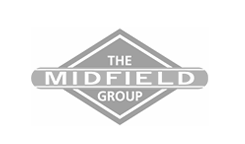

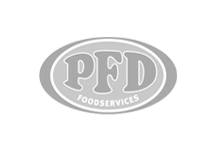


CONTACT US
OFFICE
1300 BORACKinfo@boracking.com.au
EMPLOYMENT
To apply for a position or find out more info about positions available at Bo Racking please send through a cv and resume to
